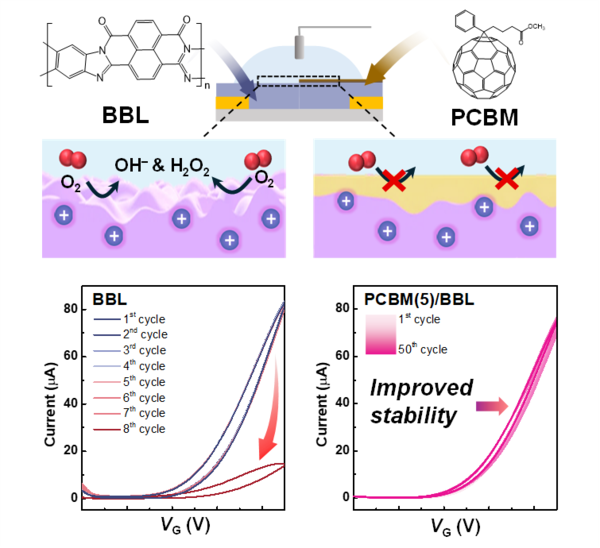
A research team led by Professor Jang Jae-young of the Department of Energy Engineering at Hanyang University announced on January 7th that they have developed a new passivation structure that suppresses side reactions occurring in aqueous electrolyte environments of organic electrochemical transistors (OECTs). This research achievement significantly improves the lifespan of OECT-based biosensors and suggests the possibility of reducing manufacturing costs through a simple solution process.
The core material of OECTs, organic mixed ionic-electronic conductors (OMIECs), retains the lightweight yet flexible characteristics of organic materials while allowing signal amplification even at low operating voltages as it enables efficient charge storage and transfer via ions. Thanks to these characteristics, OECTs can be used to develop electronic circuits utilizing biological electrolytes, and they can be used in advanced technologies such as monitoring brain, heart, and muscle signals or measuring plant growth.
While p-type OECTs had seen significant improvements in performance and stability, n-type OECTs suffered from performance degradation as they are vulnerable to moisture and oxygen. In particular, when operating in an aqueous electrolyte, the voltage formed hydrogen peroxide and hydroxide ions, leading to damage in the organic semiconductor layer and contamination of the electrolyte. These reduced the reliability of OECTs and acted as the major obstacles to the practical application of the device.
Professor Jang's research team solved this issue by introducing a passivation layer using small molecules. The team coated a small molecule, 6,6-phenyl-C61-butyric acid methyl ester (PCBM) onto an n-type OMIEC, poly(benzobisimidazobenzophenanthroline, BBL), with an optimized thickness, effectively inhibiting oxygen reduction reactions without hindering ion permeation in aqueous electrolytes.
The research team demonstrated that the high electron mobility of PCBM in comparison to BBL can enhance carrier mobility and improve the switching speed of OECTs. While unpassivated BBL OECTs retained only 17% of their initial performance after seven operational cycles of repetitive performance reviews, BBL OECTs with a PCBM layer maintained 97% of their initial performance even after more than 50 cycles, demonstrating outstanding operational stability.
This study is significant in that it secured high operational stability in an aqueous environment through surface modification. In particular, the research is expected to serve as a key technology for enhancing the performance of next-generation electronic devices, such as OECT-based bio-robots and artificial neurons.
"This study presents a structural solution to the stability issues of n-type OECTs," said Professor Jang Jae-young. "I expect the research to contribute to improving the performance of electrolyte-based wearable sensors and probe devices in the future."
The research was supported by the National Research Foundation of Korea with funding from the Ministry of Science and ICT (Nano·Material Technology Development Program—Material Global Young Connect, National Strategic Technology Materials Development), and the research findings were published in Advanced Functional Materials, a prestigious journal in the field of materials science, on February 6. The paper, titled Enhanced Stability of N-type Organic Electrochemical Transistors via Small-Molecule Passivation, was co-authored by Baek Ji-su, a doctoral student, and Dr. Oh Jong-gyu, with Professor Jang Jae-young serving as the corresponding author.

Click to see the paper:
https://advanced.onlinelibrary.wiley.com/doi/10.1002/adfm.202414916


 '한양위키' 키워드 보기
'한양위키' 키워드 보기